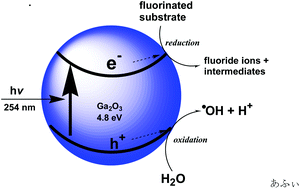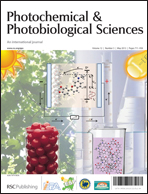Photoassisted defluorination of fluorinated substrates and pharmaceuticals by a wide bandgap metal oxide in aqueous media
Abstract
Persistent fluorinated substances, such as the fluorine-bearing pharmaceutical drugs Fluoxetine (FLX; Prozac) and Fluvoxamine maleate (FOM) together with several other substrates (fluorobenzoic acid and fluoroaliphatic model compounds), were photochemically defluorinated and degraded under UVC illumination in relatively good yields in the presence of a wide band gap metal oxide (β-Ga2O3) in heterogeneous aqueous media. The formation of fluoride ions increased with increasing illumination time under an inert nitrogen atmosphere, the transformation of the aromatic moiety was slower under these conditions, but nonetheless it did occur. The optimal amount of β-Ga2O3 loading for defluorination was 50 mg in aqueous media (0.10 mM, 100 mL); the optimal pH to defluorinate FLX was pH 6. Platinization (1 wt%) of the gallium oxide particles enhanced defluorination under an inert nitrogen atmosphere, but was decreased under an oxygen atmosphere; however, in the latter case the degradation of the substrates was facilitated as witnessed by loss of the aromatic moiety. The Ames test on the intermediate products from the photodegradation of FLX and 4-(trifluoromethyl)benzoic acid after long illumination times revealed that none were mutagenic.


 Please wait while we load your content...
Please wait while we load your content...